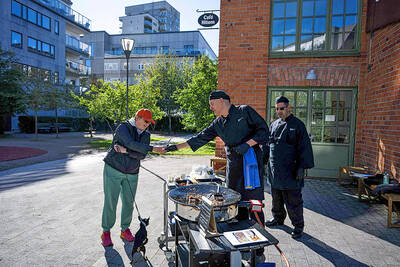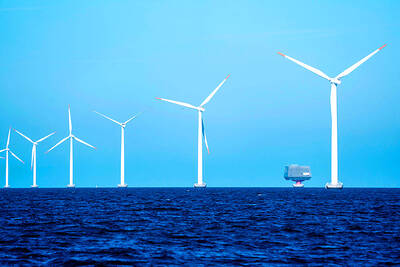Engineers mulled options yesterday after the first try to cap a ruptured pipe gushing oil into the Gulf of Mexico failed when ice crystals clogged a containment dome.
Officials said they have not yet given up hope of capping the leaks about 1,500m below the surface which are hemorrhaging an estimated 210,000 barrels a day.
But they cautioned it would likely be several days before a solution is found.
“I wouldn’t say it’s failed yet …What we attempted to do last night didn’t work because these hydrates plugged up the top of the dome,” said Doug Suttles, chief operating officer for British energy giant BP, which is responsible for the cleanup.
Clearing out the slushy crystals is easy — the 90-tonne chamber just has to be raised to warmer levels, Suttles told reporters. Keeping the crystals out so that a pipe can be lowered into the dome to suck the oil to a waiting barge is another matter.
The engineers are looking at ways to heat the frigid water in the dome, among other options, and have moved the concrete and steel box to rest on the seabed abour 200m away while they evaluate their options.
BP has already begun drilling relief wells to stem the flow, but it will take about three months for them to be operational.
It is also considering other temporary measures like trying to plug the leaks by injecting ground-up material in a “junk shot,” but Suttles said BP cannot proceed until it is sure that that “won’t make the situation worse.”
The BP official said his company had anticipated encountering hydrates, but had not thought they would be a significant a problem. The expectation was that the dome would be operational today, enabling BP to collect about 85 percent of the leaking crude by funneling it up to a barge on the surface.
An estimated 13.3 liters of oil has formed a slick the size of a small country which threatens the fragile coastal wetlands of Louisiana and the beaches of Mississippi, Alabama and Florida.
Favorable winds have kept the bulk of the oil from reaching shore since the BP-leased Deepwater Horizon sank about 80km southeast of Venice, Louisiana on April 22, two days after an explosion that killed 11 workers.
But with a thin sheen of oil now lapping Louisiana’s coastal islands, local leaders begged for more booms to protect vulnerable coastal wetlands and wildlife preserves, as well as multi billion-dollar fishing and tourism industries.
“It’ll be so much harder to clean up this oil if it gets into the marshes,” Louisiana Governor Bobby Jindal said.
The US Coast Guard, which is overseeing the recovery effort, cautioned that resources must be used “strategically.”
“There’s not enough to completely boom off every piece of coastline for all four [gulf] states,” Coast Guard Petty Officer David Mosley said.
Fears are growing that the disaster is already impacting sea life in a region that is home to vital spawning grounds for fish, shrimp and crabs and a major migratory stop for rare birds.
“It’s going to destroy the industry — it will never recover if the oil gets into the marshlands,” said Cliff LeBoef, whose Louisiana oyster beds are only now recovering from the devastation of Hurricane Katrina in 2005.

READINESS: According to a survey of 2,000 people, 86 percent of Swedes believe the country is worth defending in the event of a military attack Swedes are stocking up on food items in case of war, as more conflict in Europe no longer feels like a distant possibility, and authorities encourage measures to boost readiness. At a civil preparedness fair in southwest Stockholm, 71-year-old Sirkka Petrykowska said that she is taking the prospect of hostilities seriously and preparing as much as she can. “I have bought a camping stove. I have taken a course on preservation in an old-fashioned way, where you can preserve vegetables, meat and fruit that lasts for 30 years without a refrigerator,” Petrykowska said. “I’ve set aside blankets for warmth, I

FRUSTRATIONS: One in seven youths in China and Indonesia are unemployed, and many in the region are stuck in low-productivity jobs, the World Bank said Young people across Asia are struggling to find good jobs, with many stuck in low-productivity work that the World Bank said could strain social stability as frustrations fuel a global wave of youth-led protests. The bank highlighted a persistent gap between younger and more experienced workers across several Asian economies in a regional economic update released yesterday, noting that one in seven young people in China and Indonesia are unemployed. The share of people now vulnerable to falling into poverty is now larger than the middle class in most countries, it said. “The employment rate is generally high, but the young struggle to

ENERGY SHIFT: A report by Ember suggests it is possible for the world to wean off polluting sources of power, such as coal and gas, even as demand for electricity surges Worldwide solar and wind power generation has outpaced electricity demand this year, and for the first time on record, renewable energies combined generated more power than coal, a new analysis said. Global solar generation grew by a record 31 percent in the first half of the year, while wind generation grew 7.7 percent, according to the report by the energy think tank Ember, which was released after midnight yesterday. Solar and wind generation combined grew by more than 400 terawatt hours, which was more than the increase in overall global demand during the same period, it said. The findings suggest it is

‘ARMED CONFLICT’: At least 21 people have died in such US attacks, while experts say the summary killings are illegal even if they target confirmed narcotics traffickers US forces on Friday carried out a strike on an alleged drug-smuggling boat off the coast of Venezuela, killing four people, US Secretary of Defense Pete Hegseth said. The latest strike, which Hegseth announced in a post on X, brings the number of such US attacks to at least four, leaving at least 21 people dead. An accompanying video shared by Hegseth showed a boat speeding across the waves before being engulfed in smoke and flames. “Four male narco-terrorists aboard the vessel were killed,” the Pentagon chief wrote. He said the strike “was conducted in international waters just off the